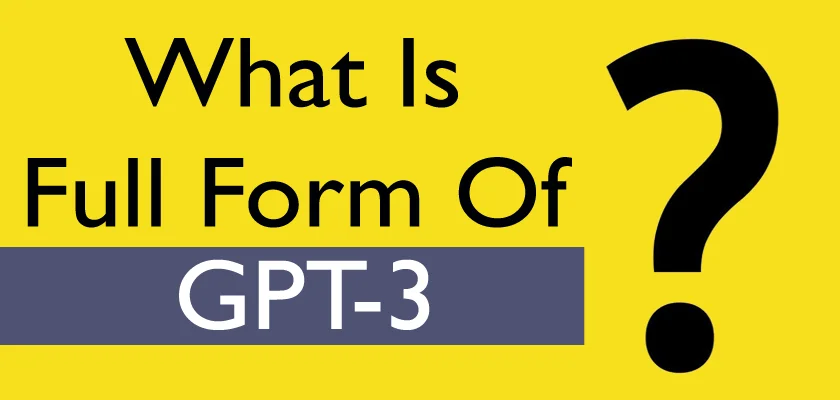Do you know what is the GPT-3 Full Form? GPT-3 Full Form stands for “Generative Pre-Training Transformer 3.” It is a language-processing artificial intelligence model developed by OpenAI. GPT-3 is capable of performing a wide range of language-based tasks, including translation, summarization, question answering, and text generation. It is trained on massive amounts of data and uses a Transformer architecture, which allows it to process input text and make predictions based on patterns learned in the data. GPT-3 is considered a major advance in natural language processing and has attracted significant attention in the media and in the field of artificial intelligence.
Table of Contents
What can GPT-3 do?
Generative Pre-trained Transformer 3 (GPT-3 Full Form) is a language generation artificial intelligence model that can able to generate human-like text, complete tasks such as translation, summarizing and question-and-answer, and create content such as articles and social media posts. It can also perform linguistic functions such as language translation and language summarization. Additionally, it has the ability to understand and respond to natural language input, allowing it to be used in conversational AI applications such as chatbots.
Some examples of Chat GPT-3
These are some most useful examples of GPT-3-
- Creating personalized email or customer service responses
- Code or programming script
- Chatbot conversation generation
- Text completion in the search bar or messaging app
- Translate text from one language to another
- Automatic summary of news articles
- Create a product description or advertisement
- Produce music or poetry
- Create articles or blog posts
How does GPT-3 work?
GPT-3 works from a language-processing artificial intelligence. It is a type of autoregressive language model, which means that it uses a sequence of words to predict the next word in the sequence.
GPT-3 works by first processing a large dataset of text, such as a corpus of books or articles, and learning the patterns and structures of the language. This process is called pre-training. During pre-training, the model is fed a sequence of words and learns to predict the next word in the sequence based on the patterns it has learned from the data.
After pre-training, the model can use to be fine for specific tasks, such as translation or language generation. When given a prompt or input text, the model uses the patterns it has learned to generate output text that is coherent and similar in style to the input text.
GPT-3 is unique in its ability to generate high-quality text because it has been trained on a large dataset and uses a transformer architecture, which allows it to effectively process and understand long-range dependencies in language. It can generate human-like text that is often difficult to distinguish from text written by a person.
The Brief History of GPT-3 Full Form

GPT-3 (Generative Pre-training Transformer 3) is a natural language processing (NLP) model that was first announced in May 2020 and officially released in June 2021.
GPT-3 is the third iteration of the GPT series, following GPT and GPT-2. GPT was released in 2018 and was the first model in the series to use the Transformer architecture, which allows for the efficient and effective processing of large amounts of data. GPT-2 was released in 2019 and was significantly larger and more powerful than its predecessor, with a capacity of 1.5 billion parameters.
GPT-3 is the largest and most advanced model in the GPT series, with a capacity of 175 billion parameters. It is designed to generate human-like text and has the ability to perform a variety of tasks, including language translation, summarization, question answering, and more.
GPT-3 has received significant attention in the media and has been hailed as a major milestone in the field of NLP and artificial intelligence. However, it has also raised concerns about the potential ethical and societal implications of advanced machine learning technologies.
Some risks and limitations of GPT-3
There are some risks and limitations to consider when using GPT-3:
Misuse: GPT-3 has the potential to be used for malicious purposes, such as generating fake news or impersonating individuals online. It is important to use GPT-3 responsibly and to verify the accuracy and authenticity of any content it generates.
Discrimination: GPT-3 is trained on a dataset of human-generated text, which may have biases and stereotypes. This can result in GPT-3 generating biased outputs, particularly if it is used to generate content that is meant to represent a particular group of people.
Output quality: While GPT-3 can produce human-like text, it is not perfect and can produce output that contains errors or is inconsistent. It is important to carefully review and edit any content generated by GPT-3 to ensure its quality.
Lack of interpretability: GPT-3 is a black box model, which means it is difficult to understand how it makes decisions or produces outputs. This can make it difficult to understand why it is making certain predictions or producing certain outputs, which may limit its usefulness in some contexts.
Data privacy: GPT-3 requires access to large amounts of data in order to function properly, which raises concerns about data privacy. When using GPT-3 it is important to consider the potential risks to data privacy and to ensure that any data used to train or operate it is handled responsibly.
Thanks for reading What is the GPT-3 Full Form? Bookmark our website Whatisfullform.com to know or read our collection of full forms.


